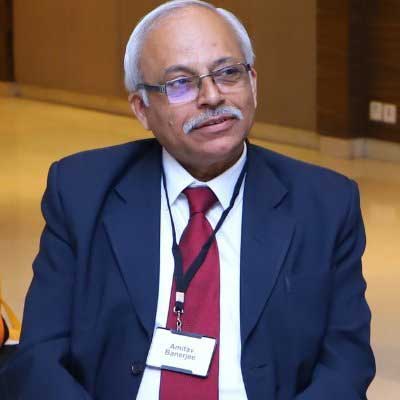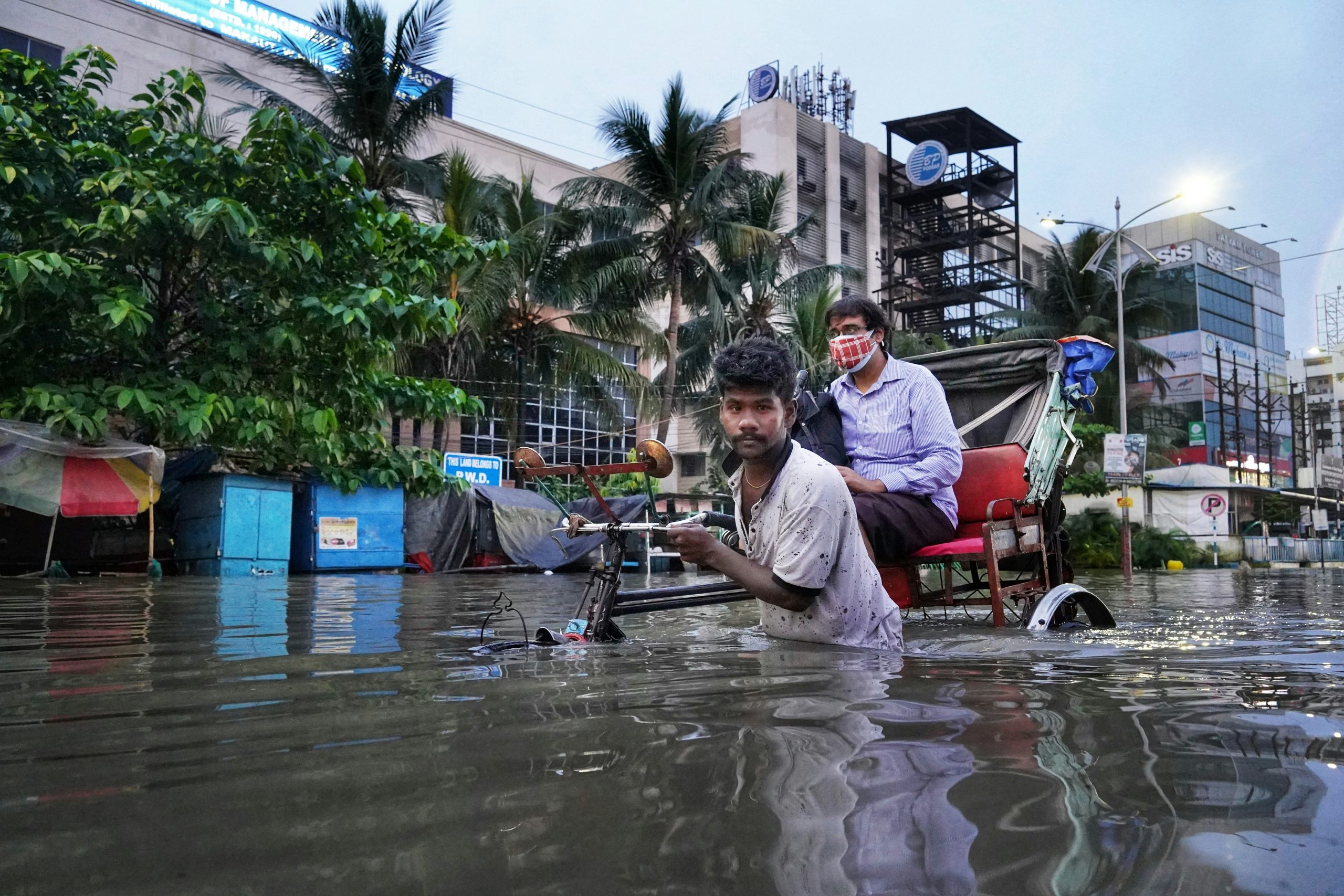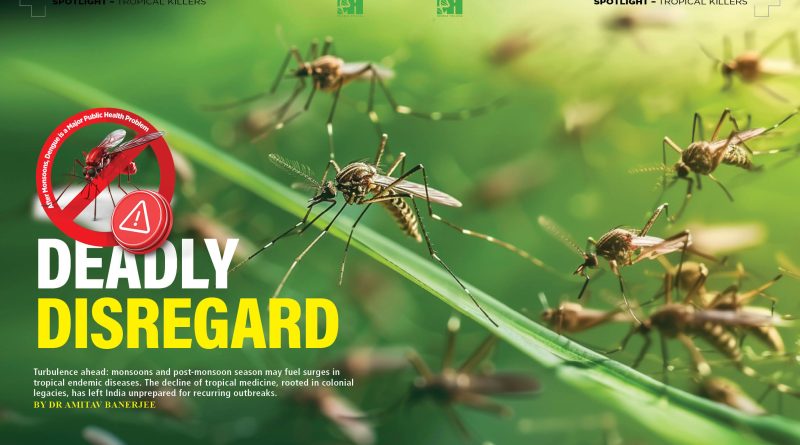Deadly Disregard
 Turbulence ahead: monsoons and post-monsoon season may fuel surges in tropical endemic diseases. The decline of tropical medicine, rooted in colonial legacies, has left India unprepared for recurring outbreaks.
Turbulence ahead: monsoons and post-monsoon season may fuel surges in tropical endemic diseases. The decline of tropical medicine, rooted in colonial legacies, has left India unprepared for recurring outbreaks.
By Dr Amitav Banerjee
Our country is diverse. This diversity extends to various disease outbreaks peculiar to specific regions of our vast population, driven by climatic variations and population demographics. Year after year, they recur with changing seasons, taking a heavy toll on the most vulnerable—our children. The worst periods for disease outbreaks in our country are the monsoons and post-monsoon seasons. Preventing these outbreaks of endemic diseases, which have become regular and recurring features year after year, should begin well before the onset of monsoons. This calls for inter-sectoral collaboration and public participation.
Frequent phenomena desensitise. The affected populations become resigned to their fate, while public health authorities drift into apathy. The diseases currently endemic in the tropics once held interest for Western countries and influenced their public health priorities.
If you don’t have bread, eat cake!
We are carrying the wrong public health compass to guide our health policies. This is best illustrated by outbreaks of “mysterious fevers” in many parts of our largest state, Uttar Pradesh, spreading to neighbouring states during the ongoing Covid-19 pandemic, when the entire country was awaiting, panic-stricken, the “paediatric third wave.”

In the post-monsoon period of 2021, when the country was preparing for the “paediatric third wave,” an outbreak of “mystery fever” spread from Firozabad in Uttar Pradesh starting in August, before the UP government identified it as dengue. More than a hundred people died after suffering high fever across five states in northern and eastern India.
Firozabad, the epicentre of the “mystery fever” among children, is a city in Uttar Pradesh with a population of six lakh, near Agra, famous for its glassmaking industry. The population density is over 1,000 per km², more than twice the national average. The city lies on a national highway, making it an important stopover for passing transport vehicles. The district includes a large rural belt with frequent rural-urban movement of people in search of employment. These factors create an ideal environment for the spread of febrile illnesses from this epicentre to other parts of the state and neighbouring states.

The outbreak of “mystery fever” hit hard, leading to confusion and chaos. People fled entire villages as many, mostly children and young people, died from the mysterious fever. According to media reports, thousands in Firozabad district were bedridden with fever at home and in hospitals. In a short period, there were 71 reported deaths, of which, tragically, 52 were children. Out of a mere 185 samples tested, 73 were positive for dengue, 28 for scrub typhus, and one for Japanese encephalitis.
In the 18th century, when told that citizens had no bread, the French queen reportedly remarked, “Let them eat cake.” We are experiencing the same ethos among our health policymakers, allowing our priorities to be dictated by the West. Here we were, with one of the largest states in the country in the grip of a “mysterious fever” killing mostly children and young people, while all our health resources were deployed for mass Covid-19 vaccination, which rarely affected young people, and quixotically preparing for a paediatric third wave that never materialized. To add insult to injury, vaccine trials for Covid-19 were conducted among children in unholy haste. Schools remained closed, ostensibly to protect children from a “lethal” virus. The panic among parents was sustained, prompting many to rush for a vaccine for their children before schools reopened.

UP health officials confirmed this mindset in a statement, noting that with increasing cases of this “mysterious disease,” the situation was fast becoming Covid-like. What a naïve approach! With so many deaths from the endemic “mysterious fever,” only 185 samples had been tested a month into the outbreak to identify it, compared to lakhs of RT-PCR tests to detect the “Covid-19 cake” in both young and old during the same period!
Post-pandemic, we are losing sight of our endemic tropical diseases in the blind chase of a pandemic virus or awaiting the next pandemic of “Disease X.” The following endemic diseases in our country surge during environmental disturbances due to heavy rains, floods, natural disasters, and population movements.

Dengue
After monsoons, dengue is a major public health problem year after year. It is a leading cause of hospitalisation and death among children and young people. Death rates can vary from 2 per cent to 20 per cent, depending on severity and access to early diagnosis and management. The dreaded dengue haemorrhagic fever, with a severe drop in platelets and bleeding, can be fatal.
The dengue virus is transmitted by the bite of Aedes mosquitoes, which thrive in artificial water containers. The mosquito, known as the tiger mosquito, is a daytime biter. There are four serotypes of the virus, and previous infection with one serotype does not protect against subsequent infection by a different serotype; in fact, it makes a person more vulnerable to dengue haemorrhagic fever syndrome.
Scrub Typhus
This is caused by rickettsiae, a small bacterium, named after Howard Ricketts, the American pathologist who died of it after discovering it. Scrub typhus is transmitted by the bite of mites that thrive in grassy soils. Post-monsoons, these grassy “mite islands” expand. The cycle of transmission continues in nature between mites and rodents. Children playing on grassy terrain and campers are vulnerable to infection from mite bites. Scrub typhus is treated with antibiotics of the tetracycline group. When treated early, the mortality rate is 1.6 per cent. In missed or untreated cases, mortality can reach 30–35 per cent, or 500 times that of the “dreaded” Covid, to provide perspective.
Japanese Encephalitis (JE)
Japanese encephalitis (JE) is a viral infection that can affect the central nervous system. It is transmitted by Culex vishnui mosquitoes, which breed in rice fields. The natural cycle involves mosquitoes and pigs or other animals, such as cattle and certain birds of the Ardeidae family. These animals and birds do not suffer from illness (except horses) but act as amplifier hosts, enabling the virus to multiply within them. Most infections are asymptomatic, but JE can be fatal in children and young adults, with a case fatality rate of 20 per cent to 40 per cent. Neurological deficits in survivors are common. A vaccine is available and should be used judiciously in endemic areas, particularly in rural regions with rice fields.
The lack of insight into epidemiology, resulting from the decline of tropical medicine as a discipline, is evident in the recent misuse of the JE vaccine. In 2025, lakhs of school children in urban Pune were vaccinated against JE following a single non-fatal case reported in 2022. Urban Pune has no rice fields, and JE virus transmission is unlikely. Serological surveys and entomological studies could have confirmed this before launching a mass JE vaccination drive in a non-endemic area, which represents a waste of resources with no risk-benefit considerations.
Leptospirosis
Post-monsoon, leptospirosis is a recurring problem in the country. This bacterial infection spreads through wastewater contaminated by the urine of animals carrying Leptospira spirochetes. While treatable with antibiotics like penicillin, death rates can range from 5 per cent to 30 per cent, depending on diagnostic and treatment facilities. After heavy rains, people wading through water may contract leptospirosis through cuts or abrasions on the skin.
Other Endemic Diseases
Other endemic diseases, such as malaria, typhoid, diarrheal diseases, hepatitis A, and hepatitis E, increase post-monsoon. Malaria surges due to the increased density of vector mosquitoes, while others result from contaminated water bodies. Malaria, though treatable, can lead to rapid deterioration in cases of untreated Plasmodium falciparum malaria, with a fatality rate of 20 per cent. Typhoid has a fatality rate of 1 per cent to 4 per cent with treatment, but without treatment, mortality can reach 10 per cent to 30 per cent. Diarrhoea kills over 1,000 children in India daily. A recent outbreak of Guillain-Barré syndrome in Pune, with over 200 cases and 11 deaths, was attributed to water contamination with Campylobacter jejuni bacteria, though other triggers, such as a Zika outbreak a few months prior, could not be ruled out.
These are our unfinished agenda. These endemic illnesses take a far higher toll on the young in our country than any present or future pandemics. We have enough work to do without awaiting a pandemic of “Disease X.” The following paragraphs provide an overview of the reasons for our failure to address these recurring public health problems.
Tropical Medicine Went Down with the “British Raj” and Continues to Be Neglected
Power dynamics dictate public health priorities. During the 17th and 18th centuries, European doctors studied tropical endemic diseases in countries like India because these diseases were prevalent in their own countries and because controlling them aided colonial dominance. Tropical medicine was a by-product of the British Raj. Investment in research and control of tropical diseases was driven by vested interests: first, preserving the health of British officials, and second, applying lessons learned to eliminate these diseases in their home countries.
During the British Raj, tropical medicine emerged as a distinct discipline encompassing public health, hygiene, population migration, epidemiology, and the natural history of disease, spurred by the evolving “germ theory.” Researchers like Manson and Ross (who received the Nobel Prize in 1902 for his work on malaria) contributed to medical parasitology and entomology in the tropics.
End of Colonisation and the Fall of Tropical Medicine
After World War II and the end of the British Raj, tropical medicine lost the attention of Western powers. Improved living standards eradicated these diseases in their countries, and the health issues of the tropics no longer affected their populations after they withdrew from the colonies. The discipline gradually shifted to “travel medicine” in Western literature, focusing on temporary preventive measures for tourists or business travellers visiting the tropics.
India Should Have Continued the Legacy of Tropical Medicine to Address Our Endemic Diseases
Regrettably, years of dependence on the Raj for scientific cues led Indian doctors to neglect tropical medicine, at a huge cost to public health. Vast swathes of our population still lack the living standards that many European countries enjoyed post-World War II. Against this backdrop, we can ill afford this drift. Our unfinished agenda of communicable diseases remains. Controlling seasonal endemic diseases that periodically escalate into epidemics would enable better governance and economic development.
Market forces driven by the pharmaceutical industry add complexity. As long as tropical endemic diseases remain uncontrolled, the pharmaceutical industry thrives. Most research projects in tropical countries, funded by these agencies, focus excessively on clinical trials rather than addressing the root causes of diseases. With high-pressure promotions and vested interests at play, the resurgence of tropical medicine is unlikely.
The Way Forward
India, with its extensive scientific resources and knowledge, should set its own public health priorities based on the regional epidemiology of endemic diseases. Given the demographic diversity, varied climates, terrains, and cultures—all of which significantly influence population health—the concepts of “One Health” and global health “treaties” risk leaving developing and tropical countries disadvantaged due to power dynamics. These should be approached cautiously.
(Currently, Professor Emeritus at Dr D Y Patil Medical College in Pune, the author has over two decades of experience serving as an epidemiologist in the armed forces. He has been ranked in Stanford University’s list of the world’s top 2 per cent scientists for two consecutive years, 2023 and 2024.)

